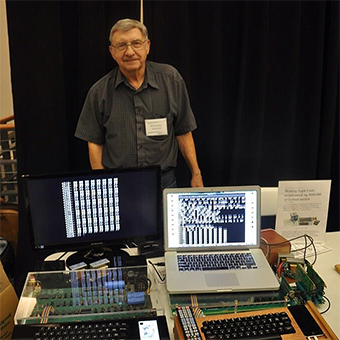Computing pioneer Lee Felsenstein with two of his creations, the SOL-20 and Osborne-1 computers
I never belonged to Silicon Valley’s famous Homebrew Computer Club. I was a little too young to have joined it in its prime, and I lived on the wrong coast. But by the time I got interested in PCs in 1978, it was already the stuff of legend. Newbies like me merely used mass-produced microcomputers; Homebrew members designed and built their own machines. I was in awe of their skills.
I still am. And on Monday night, I got my chance to rub elbows with some of those members and experience, at long last, an approximation of the Homebrew experience. The Computer History Museum hosted a 38th anniversary reunion of the organization, funded by a successful Kickstarter campaign and attended by dozens of original members, plus a gaggle of other long-time PC enthusiasts, tech-history nerds and wannabes such as me. (Not that everybody in attendance was an old-timer: A show of hands revealed that a goodly percentage of the crowd wasn’t alive in 1975 when the first Homebrew meetings were held.)

Wendell Sander with his original Apple-1 (left) and a modern Apple-1 clone (right, in wooden case, using a MacBook Pro as its display)
The most iconic Homebrew member may be Apple cofounder Steve Wozniak; in its earliest days, the company he and Steve Jobs started was practically a spinoff from the club. Woz attended the reunion and spoke effusively about how Homebrew’s mission of making computers part of everyday life inspired Apple’s first computer, the Apple-1 (now a rare and valuable collectible).
Homebrew would have been a fascinating, seminal organization even if it had played no role in Apple’s founding. Other key early PC companies such as Processor Technology and Cromemco also sprung from it; Steve Leininger, the designer of Radio Shack’s TRS-80, was a member. And the open exchange of ideas that went on at its biweekly meetings did as much as anything to jumpstart the entire personal-computing revolution. It was the crucible for an entire industry.
Even its underside was historic: At the reunion, Processor Technology cofounder Bob Marsh said that Homebrew members invented software piracy by sharing unauthorized paper-tape copies of Altair BASIC, a practice he said was the BitTorrent of its time. (Bill Gates, co-creator of Altair BASIC and general partner in a startup called Micro-Soft, famously took out an ad in the Homebrew newsletter to complain about the theft.)
Like original Homebrew meetings, the reunion wasn’t about formal presentations so much as ad-hoc demos, discussions and information-sharing. And though I spotted a few MacBooks, they were outnumbered by computers of the sort you’d expect to spot at Homebrew, including including more MITS Altairs than I’ve ever seen in one place.
Among those present who I chatted with:
- Lee Felsenstein, who designed two major computers (the Sol-20 and Osborne-1) and presided over the original club’s meetings. He moderated the on-stage portion of the reunion, adding to the event’s general you-are-there feel.
- Paul Terrell, whose Byte Shop was Silicon Valley’s first computer store and the very first Apple retailer.
- Wendell Sander — best known as the designer of the ill-fated Apple III — who brought his own Apple-1 to the reunion. (One inauthentic-but-neat touch: Sander’s unit stores programs on an iPod Touch instead of the tape deck the computer originally used.)
- Chris Espinosa, who started at Apple in 1976 — like Woz and Terrell, he’s a character in the Ashton Kutcher Jobs movie, which includes a scene set at a Homebrew meeting — and who still works at the company.
- The New York Times’ veteran tech reporter John Markoff, who told me that he wasn’t a Homebrew member but did cover meetings as a journalist.
Also not an original member but present for the reunion: Ted Nelson, the legendary visionary/iconoclast who coined the words “hypertext” and “hypermedia” and wrote Computer Lib/Dream Machines, a prescient 1974 book popular among Homebrew members. His funny and idiosyncratic speech was one of the night’s highlights — and I was pleased to learn that a 1950 issue of TIME inspired his interest in computers.
The mid-1970s, when Homebrew mattered so much, seem like a long time ago. But the fact that so many original members were able to attend Monday’s event is a reminder of just how new the computer era still is. The giants whose shoulders we all stand on are still very much with us — and that’s a fact worth cherishing.
CNET’s Daniel Terdiman, who was also at the reunion, has a good writeup and more photos.




